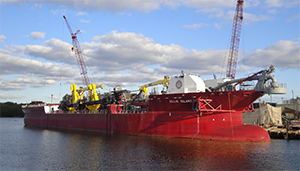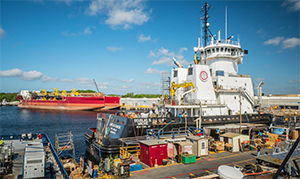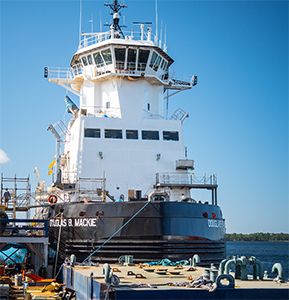Great Lakes Dredge and Dock Company describes its new articulated tug-barge unit as “a game changer” and it’s easy to see why.
The 15,442-bhp tug Douglas B. Mackie and its hopper dredge barge Ellis Island are indeed unusual vessels. As they enter service this year, the barge will be the largest of its kind in the U.S. fleet. Together, the tug and barge represent the first ATB hopper dredge built in the U.S.
Another feature sets them apart: They will be remarkably fast for vessels of this type, capable of 14 knots with the barge fully loaded.
Speed might not seem like a major concern when deepening a navigation channel or pumping sand onto a low-lying coastal area threatened by rising sea levels. Yet moving briskly between the dredging site and the dumping spot will be crucial to the ATB’s success.
“In dredging, to be competitive you want to be the low-unit-cost provider. In our research and development, that was our goal,” said Steve Becker, GLDD’s senior vice president, plant and equipment.
The amount of dredged material a vessel can carry in its hopper is a big factor in unit costs. Ellis Island has a capacity of 14,788 cubic yards — roughly 18 percent more than the next largest U.S. hopper dredge, according to Becker.
Time spent moving the hopper is also a major contributor to unit costs. On a land reclamation project, for example, the distance between the offshore source of the sand and land being reclaimed may be 50 miles. The dredge also will load and unload multiple times a day. “To be competitive, you need to be able to sail long distances at a given speed,” Becker said.
GLDD went to great lengths to achieve optimal hull forms for the tug and barge. The two hulls of an ATB are not as efficient as the single hull of a conventional ship. GLDD performed tank testing at MARIN (Marine Research Institute Netherlands) in Wageningen, Netherlands.
As a dredge, the GLDD ATB has operating characteristics that set it apart from typical ATBs — many of which transport oil products. Such ATBs are loaded and unloaded at the dock in static conditions, and the tug can disconnect from the barge as its draft changes. By contrast, the GLDD unit takes on and discharges its loads at sea in a variety of conditions. That means the GLDD ATB dredge has to adjust the connection in varying sea states as the relative elevation between the tug and the barge changes.
Another complication: This ATB will spend most of its time in shallow water, defined as no more than 1.5 times the vessels’ draft. The tug’s load-line draft is 27.3 feet.
Consequently, “all the model testing was done in shallow-draft conditions,” Becker said. “The lines of the stern of the tug and bow of the barge are designed to be very efficient in the 1.5-times-draft range.”
 |
|
The hopper dredge barge Ellis Island has a capacity of 14,788 cubic yards. |
Shallow-water operations create the potential for diminished water flow to the tug’s propellers, reducing speed and efficiency. Computerized fluid dynamic studies and tank testing helped GLDD optimize hull lines to counteract that problem. The combination of a twin gondola tug stern and spacing the props further apart than normal helps guide water to the props by creating “a nice smooth laminar flow.” The result was an ATB exhibiting more ship-like efficiency when moving through the shallow water.
In addition to respectable speed (for a dredge), the ATB also boasts size. As noted, the 433-by-92-foot hopper dredge barge is the biggest in the industry. The rest of the ATB is sized proportionally. The company wanted “a bigger, better, stronger vessel,” Becker said.
The two dredging suction pipes on the barge are 36 inches in diameter. The discharge pipes have 34-inch diameters. Each dredge pump is powered by a 5,000-bhp EMD diesel engine. Adding the 1,260 bhp from the Caterpillar C32 auxiliary generator gives the barge a total installed diesel capacity of 11,260 bhp.
The 158.4-foot tug is powered by two 7,721-bhp MaK 12M32C diesels producing a total output of 15,442 bhp. Each main engine connects to a gearbox with two outputs: a propulsion shaft and a generator shaft. Each main shaft generator has an output capacity of 4,189 bhp, for a total of 8,378 hp.
Two Caterpillar generators on the tug add 1,850 bhp for a total installed diesel capacity of 17,292 bhp. All this power from the tug is available for propulsion, the tug’s various other systems, the bow thrusters on the barge and all dredging operations except the dredge pumps. Those are powered by the direct-drive EMD diesel engines on the barge. The tug also powers two jet pumps used to stir up the bottom when dredging and liquefy material in the hopper during unloading.
With all the diesel engines powering the systems aboard the tug and the barge, managing fuel becomes an important factor. The tug has “a very sophisticated load management program optimizing fuel consumption,” Becker said.
The tug’s controllable-pitch props play an important role in that system. Its diesel engines achieve optimal fuel consumption levels operating between 600 and 720 rpm near 100 percent load, Becker said.
Since the main engines are driving both the props and the main shaft generators, adjusting the pitch of the CP props makes it easier to distribute power needed for propulsion and other systems while keeping the engines at their optimal speed and load.
Economics are, of course, central to the ATB’s success. So too is performing the dredging work correctly, especially when it comes to navigation channels. The location, depth and width of these channels must be executed with great precision. The barge is equipped with two variable-speed, fixed-pitch bow thrusters and two Van der Velden Barke flap rudders.
“In dredging, you need a great deal of maneuverability,” Becker said. The powerful oversized rudders, combined with the bow thrusters, allow the ATB to maintain a precise course, while the CP props help the ATB carefully adjust its speed in the water.
The ATB is also equipped with a dynamic positioning/dynamic tracking (DP/DT) system. The DP helps the dredge hold position for discharging, while the DT allows for track dredging for more precise dredging or trenching.
 |
|
Ellis Island (background) is equipped with engines generating more than 11,000 hp. Twin EMD diesels each producing 5,000 hp drive the dredge pumps. Douglas B. Mackie gets propulsion from twin MaK engines producing 7,721 hp each. |
The ATB crews (who will be members of the Seafarers International Union) will work on a four weeks on, four weeks off schedule — meaning comfort will be of great importance. The exact crew size has not been determined, but the tug can accommodate up to 26 people in 18 single cabins and four doubles. Common spaces will include a lounge, exercise room, galley and mess. The boat also will carry a full-time cook.
Insulating material to minimize vibration and noise has been installed throughout. GLDD hired a consultant to evaluate those issues and advise how to come up with a design that mitigates noise and vibration. To enhance crew safety, there are no steep stairs or ladders. All accessways are built along angles of 45 degrees or less.
Two ladders connect the tug and the barge. To ensure the safest possible transfers, the ladders — one on each side of the tug — are placed at different elevations. The starboard lower ladder is for loaded barge conditions, while the higher port-side ladder is for light barge conditions. Both ladders are normally retracted on the tug. Strict communication protocols will be followed to initiate a transfer.
The firefighting system on the tug employs water mist. “We didn’t want to risk CO2 with the manned spaces,” Becker said. There is a CO2 system in the barge’s unmanned engine room.
The tug is named after a GLDD chief executive officer who served in that post from 1995 until retiring in 2010. The barge is named after the island in New York harbor that was the U.S. entry point for millions of immigrants until 1954.
GLDD is the country’s largest provider of dredging services. The ATB should stay busy once it enters service. Many East and Gulf Coast ports have deepened their channels to accommodate big post-Panamax ships passing through the Panama Canal’s enlarged system of locks. Miami recently deepened its channels, Savannah is currently undergoing dredging, and several other ports are expected to seek bids soon.
The ATB will to spend time on the Gulf Coast where large areas are being lost to erosion, subsidence and rising sea levels. The ATB’s first job is expected to be a beach replenishment project on the East Coast.
GLDD originally announced in 2012 that it had contracted with Signal International to build the ATB in Orange, Texas, using a design by Ocean Tug/Barge Engineering. In 2013 work stopped at the request of GLDD, which later settled with Signal.
In 2014, GLDD hired Eastern Shipbuilding Group in Panama City, Fla., to finish construction. Detailed engineering of the tug was done by Ship Architects and of the barge by Bay Engineering. Becker said GLDD also contributed to the design.
In spring of 2017, that effort was nearing completion at Eastern.
“This project has been a challenge,” said Steven J. Berthold, Eastern’s vice president of sales and marketing. “We’re a diversified shipyard and not afraid to take risks to help customers get their projects out the door. No matter how difficult the project, we’ve always delivered the vessel.”
When delivered this year, ATB Douglas B. Mackie/Ellis Island will get to prove itself in the U.S. dredging industry.

